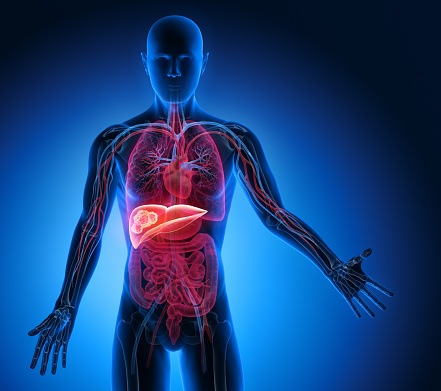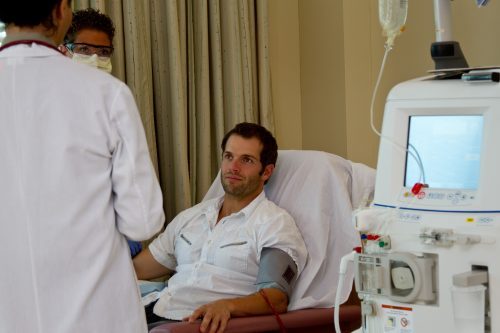
From the Chair
The hepatorenal syndrome (HRS) is one of the most dreaded and tragic illnesses to manage in nephrology. Patients are sick and mortality is very high, because treatment absent a liver transplant generally doesn’t work.1,2
HRS was first recognized in 1877 by Friedrich Theodor von Frerichs, a German pathologist, who reported the presence of oliguria in patients with ascites. In later years, others substantiated the link between liver disease and acute kidney injury. In a classic paper in the Lancet in 1956, Hecker and Sherlock described the cardinal features of HRS: renal failure with progressive oliguria, a very low urinary sodium excretion, hyponatremia, and the absence of proteinuria.
In HRS, the traditional teaching has been that the kidneys are “innocent” bystanders to a vasoconstrictive humoral factor generated by the failing liver (usually cirrhotic liver).1 Furthermore, the kidney failure is “functional and reversible” once the diseased liver is replaced by a healthy liver allograft.
HRS is classified as type 1 or type 2. Type 1 HRS (or HRS-1) is more fulminant and is characterized by a very rapid decline in renal function (doubling of serum creatinine over less than 2 weeks). Median survival for HRS-1 is less than 2 weeks. In contrast, type 2 HRS (HRS-2) runs a more chronic course and is characterized by a diuretic-resistant ascites, and a less rapid decline in renal function.
Treatment of HRS-1 is challenging.2 Different strategies, including transjugular intrahepatic portosystemic shunt (TIPS) to decompress the portal decompression and dialysis, have been tried with variable success. Both generally are viewed as temporizing measures while awaiting liver transplantation.
Among medical therapies, the most promising is the use of the vasopressin analogue terlipressin in combination with albumin. Terlipressin is widely used outside of the United States for the treatment of HRS-11,2 for more than 10 years. However, the FDA has so far not approved terlipressin in the United States, because the global trial experience has been limited (only in a few hundred patients in aggregate),2,3 and because two prior phase 3 trials have been inconclusive.
The publication on March 4, 2021, of the CONFIRM trial by Florence Wong and colleagues in the New England Journal of Medicine 4 provides exciting and important evidence in favor of terlipressin in combination with albumin for the treatment of HRS-1. An accompanying editorial by Garcia-Tsao is also very positive.3 This is welcome news for an illness that, short of liver transplantation, is usually fatal. The strengths of the CONFIRM trial are its design (randomized double-blind, placebo, control), the careful reporting of clinical outcomes and safety outcomes, and its size (the largest trial conducted so far).
The details of the CONFIRM trial are as follows. Sixty sites in the United States and Canada recruited 300 subjects (199 received terlipressin and 101 received placebo). Eligible patients had HRS-1, cirrhosis, ascites, and rapidly progressive kidney failure, with a doubling of the serum creatinine level to at least 2.25 mg/dL within 2 weeks prior to randomization. Patients were randomly assigned to either terlipressin plus albumin or placebo plus albumin. Terlipressin 1 mg or placebo was administered intravenously over 2 minutes every 5.5 to 6.5 hours.
Across the board, HRS-1 patients treated with terlipressin demonstrated benefit compared with placebo. For the primary endpoint, reversal of HRS was reported in 32% in the terlipressin group and 17% in the placebo group (P=.006). Although there was no difference in mortality between the two groups, the trial was not powered for this.
But here is the kicker—the beauty and the beast aspect of terlipressin. While adverse effects were similar in patients treated with terlipressin compared with placebo, respiratory failure and death from respiratory failure was much higher in the terlipressin group compared with placebo-treated patients (11% versus 2%).
How is terlipressin used in practice? The experience is mostly outside the United States. Terlipressin can be administered either as IV boluses or as a continuous infusion. The IV bolus approach was used in the CONFIRM trial, but a continuous intravenous infusion is also popular and has been used in other trials (from 2 mg/day to 12 mg/day).2 In a study in 2016 by Cavallin and colleagues6, administration of terlipressin by bolus was compared with continuous infusion. Similar efficacy with both means of administration was reported, but there was a much lower rate of adverse events using the infusion approach as compared to administering by bolus (35.29% vs 62.16%, P<.025).
What’s my take on the CONFIRM trial? First of all, this trial was very well conducted and in a sizable number of patients in a population that is very hard to recruit. Bravo to the investigators. Second, the trial demonstrated clear benefit and should amply reassure the FDA that this therapy works; an approval for terlipressin for HRS-1 may now be on the cards. Third, CONFIRM introduces yet another challenge in managing patients with HRS-1, which should make us think hard about using it once approved—namely the risk of acute respiratory failure. Additional trials will be needed to tease out the ideal HRS-1patient to treat with terlipressin.
References
- Ng CK, Chan MH, Tai MH, Lam CW. Hepatorenal syndrome. Clin Biochem Rev. 2007 Feb;28(1):11-7. PMID: 17603637; PMCID: PMC1904420.
- Facciorusso A. Hepatorenal Syndrome Type 1: Current Challenges And Future Prospects. Ther Clin Risk Manag. 2019 Nov 27;15:1383-1391. doi: 10.2147/TCRM.S205328. PMID: 31819465; PMCID: PMC6886557.
- https://www.fda.gov/media/139965/download
- Wong F, Pappas SC, Curry MP, et al., CONFIRM Study Investigators. Terlipressin plus Albumin for the Treatment of Type 1 Hepatorenal Syndrome. N Engl J Med. 2021 Mar 4;384(9):818-828. doi: 10.1056/NEJMoa2008290. PMID: 33657294.
- Garcia-Tsao G. Terlipressin and Intravenous Albumin in Advanced Cirrhosis – Friend and Foe. N Engl J Med. 2021 Mar 4;384(9):869-871. doi: 10.1056/NEJMe2034425. PMID: 33657300
- Cavallin M, Piano S, Romano A, et al. Terlipressin given by continuous intravenous infusion versus intravenous boluses in the treatment of hepatorenal syndrome: A randomized controlled study. Hepatology. 2016 Mar;63(3):983-92. doi: 10.1002/hep.28396. Epub 2016 Feb 3. PMID: 26659927.







 © 2025 Mashup Media, LLC, a Formedics Property. All Rights Reserved.
© 2025 Mashup Media, LLC, a Formedics Property. All Rights Reserved.